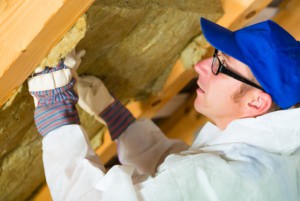Start With the Attic
 The insulation in the attic is some of the most critical in your whole home. In winter, it prevents heat from the living spaces from escaping through the roof. It also prevents the moisture problems that can occur when warm air seeps into a cold attic.
The insulation in the attic is some of the most critical in your whole home. In winter, it prevents heat from the living spaces from escaping through the roof. It also prevents the moisture problems that can occur when warm air seeps into a cold attic.
If the insulation doesn't fully cover the attic floor joists, you'll need to add more. Even if the joists are covered, it's still a good idea to measure the insulation. If you have at least 3 or 4 inches, add another R-38 layer for optimal heat resistance. That's approximately 12 inches of fiberglass batts. Loose-fill and rigid foam insulation are also options.
Check the Ducts
Inefficient ducts undermine the whole heating and cooling system. Check accessible ductwork running through the attic, basement or crawl space, and garage. If they're not insulated, add at least an R-6 layer of fiberglass or cellulose batt insulation or duct wrap. First, however, make sure the joints are securely fit and sealed with mastic or foil-backed tape.
Other Important Areas
Basement insulation reduces heat loss through the foundation and minimizes the risks of moisture and insect problems. First, check basement rim joists. If they're not insulated, sealing them with caulk and adding rigid foam insulation will go a long way toward reducing heat loss. Beyond this, you may need to install insulation with a fire-rated covering on the interior of your basement walls.
The floors and exterior walls in your living space are also critical areas for good home insulation, but they're hard to inspect on your own. A professional energy audit can help with this.
For professional help with your home insulation, contact the home comfort experts at Rodenhiser Plumbing, Heating & Air Conditioning. We proudly serve those in the Route 495/128 area of Massachusetts.
Image via Shutterstock.com